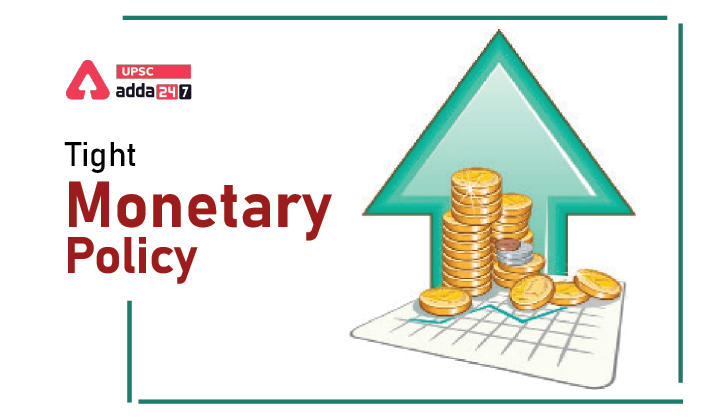Table of Contents
Tight Monetary Policy- Relevance for UPSC
Indian Economy and issues relating to planning, mobilization, of resources, growth, development and employment.
In News
Eye on inflation, RBI goes for 3rd rate hike this year
What is Monetary policy?
- Monetary policy refers to the policy of the central bank in using monetary instruments to achieve the goals specified in the RBI Act, 1934.
- The objective of the RBI’s monetary policy is to maintain price stability while keeping in mind the objective of growth which is a necessary precondition to sustainable growth.
- The amended RBI Act, 1934 sets the inflation target (4% +-2%) for Government of India in consultation with the Reserve Bank.
Instruments of Monetary Policy
- Liquidity Adjustment Facility (LAF)- The LAF consists of overnight as well as term repo auctions.
- Bank Rate– The rate at which the RBI is ready to buy bills of exchange or other commercial papers. The Bank Rate is published under Section 49 of the RBI Act, 1934.
- Repo Rate-The interest rate at which the Reserve Bank provides liquidity to banks against the collateral of government and other approved securities under the liquidity adjustment facility (LAF).
- Reverse Repo Rate- The interest rate at which the Reserve Bank absorbs liquidity, on an overnight basis, from banks against the collateral of eligible government securities under the LAF.
- Statutory Liquidity Ratio (SLR)– The share of NDTL that a bank is required to maintain in safe and liquid assets, such as, unencumbered government securities, cash and gold changes in which often influence the availability of resources in the banking system for lending to the private sector.
- Cash Reserve Ratio (CRR)- The average daily balance that a bank is required to maintain with the Reserve Bank as a share of such per cent of its Net demand and time liabilities (NDTL) that the Reserve Bank may notify from time to time in the Gazette of India.
- Marginal Standing Facility (MSF)- A facility under which scheduled commercial banks can borrow additional amount of overnight money from the Reserve Bank by dipping into their Statutory Liquidity Ratio (SLR)portfolio up to a limit at a penal rate of interest.
- Open Market Operations (OMOs)- These include both, outright purchase and sale of government securities, for injection and absorption of durable liquidity, respectively.
What is Tight Monetary Policy?
- Central banks engage in tight monetary policy when an economy is accelerating too quickly or inflation—overall prices—is rising too fast.
- The central bank tightens policy or makes money tight by raising short-term interest rates which increases the cost of borrowing and effectively reduces its attractiveness.
Monetary Policy in India
- RBI controls inflation in the country through Monetary policy in India.
- The Reserve Bank of India (RBI) is vested with the responsibility of conducting monetary policy, mandated under the Reserve Bank of India Act, 1934.
- To maintain price stability, inflation needs to be controlled and for this the government of India sets an inflation target for every five years in which RBI has an important role in the consultation process regarding inflation targeting.
- The current inflation-targeting framework in India is flexible in nature.
- Who sets the inflation target in India: The amended RBI Act provides for the inflation target to be set by the Government of India, in consultation with the Reserve Bank, once every five years.
Role of RBI
- Reserve Bank of India (RBI) operates the Monetary Policy Framework of the country.
- The amended RBI Act provides the legislative mandate to the Reserve Bank to operate the monetary policy framework of the country which aims at setting the policy (repo) ratebased on an assessment of the current and evolving macroeconomic situation, and modulation of liquidity conditions to anchor money market rates at or around the repo rate.
- Change in Repo rate affects the entire financial system, which, in turn, influences aggregate demand – a key determinant of inflation and growth.
- Once the repo rate is announced, the operating framework designed by the Reserve Bank envisages liquidity management on a day-to-day basis through appropriate actions.
Inflation in India
- Capacity utilization in the manufacturing sector in Q4 2021-22 went up to 75.3 per cent as against its long-term average of 73.7 per cent.
- RBI has also projected inflation at 6.7 per cent for the year 2022-23.
- While the consumer price inflation has eased from its surge in April, the RBI said it remains uncomfortably high and above the upper threshold of the target.
- While RBI projected an inflation of 7.1 per cent for Q2, it expects it to come down to 6.4 per cent in Q3; and 5.8 per cent in Q4. It has further projected inflation in Q1 2023-24 to be at 5 per cent.
Summary
Monetary policy refers to the use of monetary instruments by the central bank to regulate monetary tools such as interest rates, money supply and availability of credit with a view to achieving the ultimate objective of economic policy.




 TSPSC Group 1 Question Paper 2024, Downl...
TSPSC Group 1 Question Paper 2024, Downl...
 TSPSC Group 1 Answer key 2024 Out, Downl...
TSPSC Group 1 Answer key 2024 Out, Downl...
 UPSC Prelims 2024 Question Paper, Downlo...
UPSC Prelims 2024 Question Paper, Downlo...
